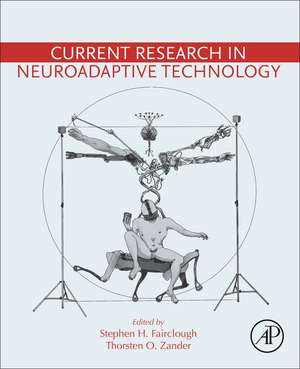Current Research in Neuroadaptive Technology
Editat de Stephen H. Fairclough, Thorsten O. Zanderen Limba Engleză Paperback – 18 noi 2021
The topic of neuroadaptive technology is novel and contemporary and editors Dr. Stephen H. Fairclough and Dr. Thorsten O. Zander have captured issues related to this emerging technology at the point of inception. It is a key reference for biomedical engineers and researchers in neural engineering, biomedical engineering, computer science, and mathematics.
- Includes applications of neuroadaptive technology in a variety of disciplines
- Comprises in-depth technical coverage of Passive Brain-Computer Interfaces, Physiological Computing, Affective Computing, Neurofeedback, and Closed-Loop Human-Computer Interaction
- Covers topics such as monitoring safety-critical behaviour, brain-computer interfaces, neurofeedback, virtual reality, neurostimulation, tangible interfaces, mobile brain-body imaging, system taxonomy and ethical implications of neuroadaptive technology
- Covers applied research using techniques such as: EEG, fNIRS, eye-tracking, psychophysiology, spontaneous radio frequency transmission and tDCS
- Written by engineers to help engineers, computer scientists, researchers and clinicians understand the technology and its applications
Preț: 957.17 lei
Preț vechi: 1198.39 lei
-20% Nou
Puncte Express: 1436
Preț estimativ în valută:
183.17€ • 191.47$ • 154.78£
183.17€ • 191.47$ • 154.78£
Carte tipărită la comandă
Livrare economică 27 februarie-13 martie
Preluare comenzi: 021 569.72.76
Specificații
ISBN-13: 9780128214138
ISBN-10: 0128214139
Pagini: 482
Ilustrații: 60 illustrations (20 in full color)
Dimensiuni: 191 x 235 mm
Greutate: 0.83 kg
Editura: ELSEVIER SCIENCE
ISBN-10: 0128214139
Pagini: 482
Ilustrații: 60 illustrations (20 in full color)
Dimensiuni: 191 x 235 mm
Greutate: 0.83 kg
Editura: ELSEVIER SCIENCE
Cuprins
1. Designing Human-Computer Interaction with Neuroadaptive Technology
2. Defining Neuroadaptive Technology: The Trouble with Implicit Human-Computer Interaction
3. The Multi-Stage Theory of Neurofeedback Learning: A Framework for Understanding Mechanisms
4. Towards Neuroadaptive Modeling: Assessing the Cognitive States of Pilots through Passive Brain-Computer Interfacing
5. Tangible Physiological Devices for Positive Computing, a Retrospective
6. The Influence of a Neuroadaptive Game as Distraction from Pain: A fNIRS study
7. Ecological Measures of Cognitive Impairments in Aeronautics: Theory and Application
8. Transcranial Direct-Current Stimulation (tDCS) Attenuates Perceived Temporal Demand During Simulated Laparoscopic Tasks
9. Adaptive Virtual Reality
10. Possibilities and Pitfalls for the Co-Registration of Mobile EEG and Eye- Tracking in the Study of Economic Decision-Making in Naturalistic Settings
11. The impact of electrode shifts on BCI Classifier accuracy
12. Walking Improves The Perfomance of a Brain-Computer Interface for Group Decision Making
13. Spontaneous Radiofrequency Emission from Electron Spins within Drosophila: a novel biological signal
Appendix
A. Abstracts from the First Neuroadaptive Technology Conference, 2017
B. Abstracts from the Second Neuroadaptive Technology Conference, 2019
2. Defining Neuroadaptive Technology: The Trouble with Implicit Human-Computer Interaction
3. The Multi-Stage Theory of Neurofeedback Learning: A Framework for Understanding Mechanisms
4. Towards Neuroadaptive Modeling: Assessing the Cognitive States of Pilots through Passive Brain-Computer Interfacing
5. Tangible Physiological Devices for Positive Computing, a Retrospective
6. The Influence of a Neuroadaptive Game as Distraction from Pain: A fNIRS study
7. Ecological Measures of Cognitive Impairments in Aeronautics: Theory and Application
8. Transcranial Direct-Current Stimulation (tDCS) Attenuates Perceived Temporal Demand During Simulated Laparoscopic Tasks
9. Adaptive Virtual Reality
10. Possibilities and Pitfalls for the Co-Registration of Mobile EEG and Eye- Tracking in the Study of Economic Decision-Making in Naturalistic Settings
11. The impact of electrode shifts on BCI Classifier accuracy
12. Walking Improves The Perfomance of a Brain-Computer Interface for Group Decision Making
13. Spontaneous Radiofrequency Emission from Electron Spins within Drosophila: a novel biological signal
Appendix
A. Abstracts from the First Neuroadaptive Technology Conference, 2017
B. Abstracts from the Second Neuroadaptive Technology Conference, 2019

























